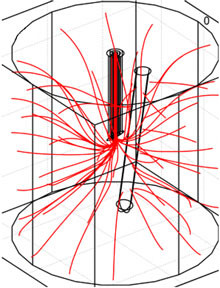Microstimulation in The Brain: Does Microdialysis Inuence the Activated Volume of Tissue?
Deep Brain Stimulation (DBS) has been established as an effective treatment for Parkinson's disease and other movement disorders. The stimulation is currently administered using tetrode-macroelectrodes that target the Subthalamic Nucleus (STN). This often leads to side effects which bias the surrounding areas, e.g. the speech centre. Targeting a specific brain region can better be achieved with micro-stimulation electrodes with directed electrical field distribution. Experimental studies showed the effectiveness of microelectrode DBS by comparing neurotransmitter outflow before and after the stimulation. The neurotransmitter outflow in close proximity to the stimulation is hereby measured by means of microdialysis. To establish ideal distances and stimulation strength, the electric potential around the stimulation electrode and microdialysis membrane were modeled using COMSOL Multiphysics.

Download
- Krapohl.pdf - 0.61MB
